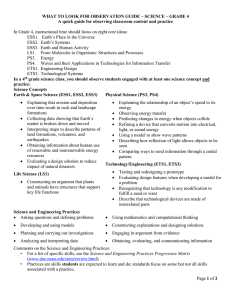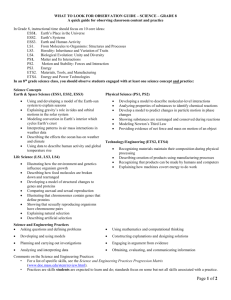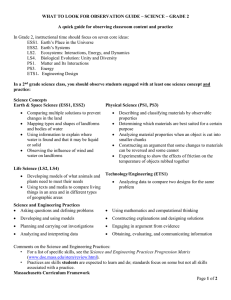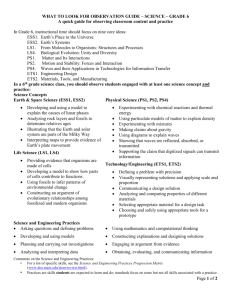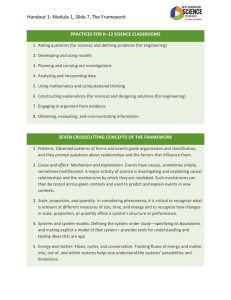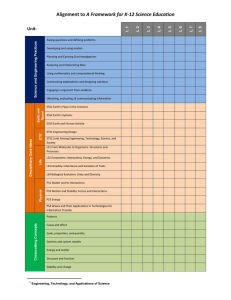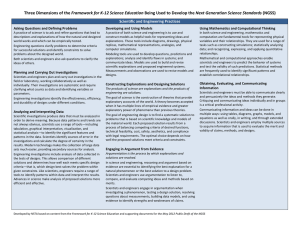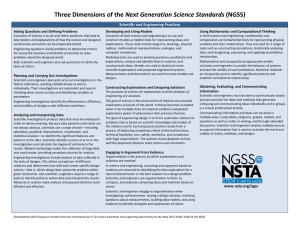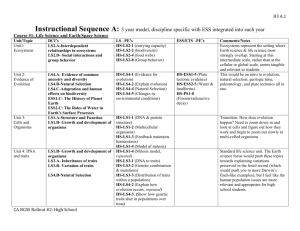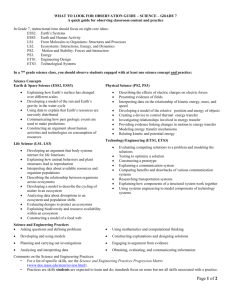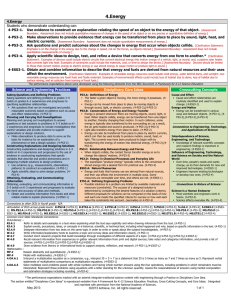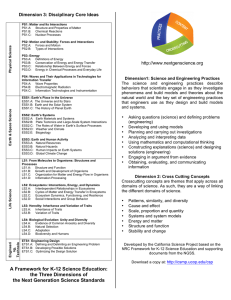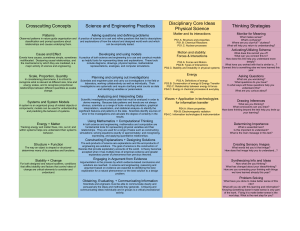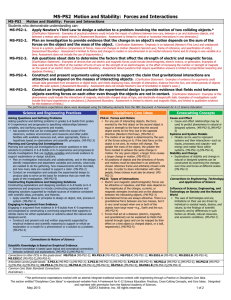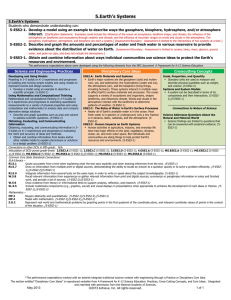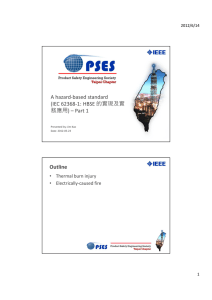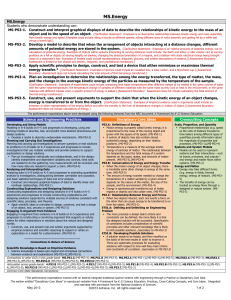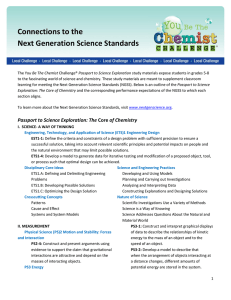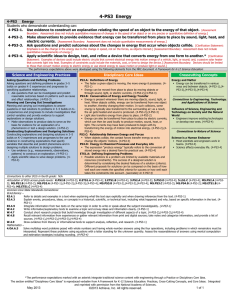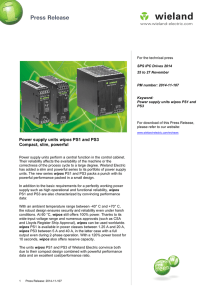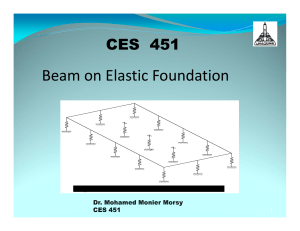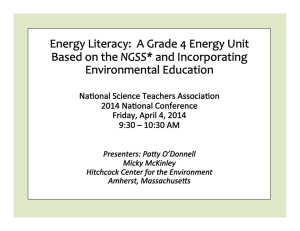sci g5
advertisement
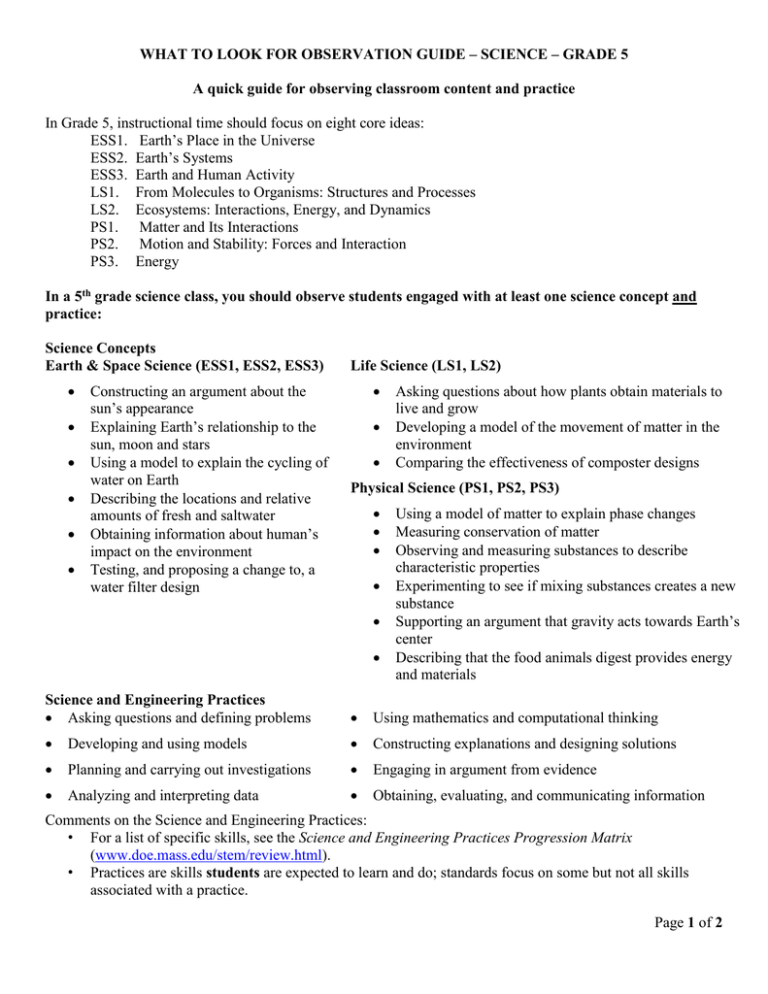
WHAT TO LOOK FOR OBSERVATION GUIDE – SCIENCE – GRADE 5 A quick guide for observing classroom content and practice In Grade 5, instructional time should focus on eight core ideas: ESS1. Earth’s Place in the Universe ESS2. Earth’s Systems ESS3. Earth and Human Activity LS1. From Molecules to Organisms: Structures and Processes LS2. Ecosystems: Interactions, Energy, and Dynamics PS1. Matter and Its Interactions PS2. Motion and Stability: Forces and Interaction PS3. Energy In a 5th grade science class, you should observe students engaged with at least one science concept and practice: Science Concepts Earth & Space Science (ESS1, ESS2, ESS3) Constructing an argument about the sun’s appearance Explaining Earth’s relationship to the sun, moon and stars Using a model to explain the cycling of water on Earth Describing the locations and relative amounts of fresh and saltwater Obtaining information about human’s impact on the environment Testing, and proposing a change to, a water filter design Life Science (LS1, LS2) Asking questions about how plants obtain materials to live and grow Developing a model of the movement of matter in the environment Comparing the effectiveness of composter designs Physical Science (PS1, PS2, PS3) Using a model of matter to explain phase changes Measuring conservation of matter Observing and measuring substances to describe characteristic properties Experimenting to see if mixing substances creates a new substance Supporting an argument that gravity acts towards Earth’s center Describing that the food animals digest provides energy and materials Science and Engineering Practices Asking questions and defining problems Using mathematics and computational thinking Developing and using models Constructing explanations and designing solutions Planning and carrying out investigations Engaging in argument from evidence Analyzing and interpreting data Obtaining, evaluating, and communicating information Comments on the Science and Engineering Practices: • For a list of specific skills, see the Science and Engineering Practices Progression Matrix (www.doe.mass.edu/stem/review.html). • Practices are skills students are expected to learn and do; standards focus on some but not all skills associated with a practice. Page 1 of 2 WHAT TO LOOK FOR OBSERVATION GUIDE – SCIENCE – GRADE 5 Science and Technology/Engineering What to Look For Guide The practices below, which are aligned to the MA Model Teacher Rubric, should be evident in planning and instruction. Any particular lesson will demonstrate some of the practices, not all. For each lesson, artifacts or observables might include: lesson plan, tasks and assessments, teacher instruction, student discussion and behavior, or student work. Standard I: Curriculum, Planning, and Assessment (I-A, I-B) Standard II: Teaching all Students (II-A) The lesson focuses on grade-level standard(s). The teacher actively engages students in authentic scenarios that provide opportunities to make sense of phenomena or design solutions. The lesson integrates science and engineering practice(s) with core idea(s) to support development of skills and conceptual understanding. The lesson engages students in making sense of relevant phenomena or solving relevant problems (through firsthand experiences or representations). The teacher promotes the use of evidence and provides time for students to communicate, clarify, justify, and represent their thinking about the content of the lesson. The teacher uses variation in students’ ideas and strategies to strengthen other students’ understanding. The teacher addresses student variability, and meets diverse needs (including English Language Learners and students with disabilities) to ensure equitable access to the lesson and achievement of the standard(s). The teacher references student work and discussion to summarize the practices and core ideas learned. The lesson intentionally relates new learning to students’ prior skills and knowledge. The lesson provides grade-appropriate connection(s) to Literacy and/or Mathematics standards. The lesson includes opportunities to monitor learning throughout the lesson (such as through questioning or student performance assessments). NOTES: See the full set of Standards and Indicators in ESE’s Model Teacher Rubric (http://www.doe.mass.edu/edeval/model/PartIII_AppxC.pdf). Massachusetts Curriculum Framework Page 2 of 2
